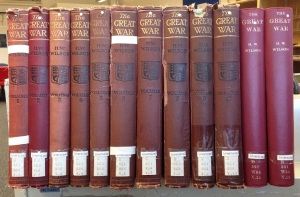A blog post by Zoe Farace and Antonia Fernandes, Special Collection Volunteers.

For the last 100 years, the end of the Great War (1914-1918) and later other major wars have been commemorated on what had been known as Armistice Day (when the war had formally ended) and is now called ‘Remembrance Day’. Typically on this day, at the 11th hour, a two minutes silence is held in order to show respect for the men and women who have challenged the enemy and sacrificed their lives for their country. The tradition has been maintained to this day and this year the Royal British Legion, who hold a Poppy Appeal every year, are encouraging people to put down their smart phones and log out of social media, as a way of showing respect this year. It is clear that this act is the ultimate way of showing respect to those who fought and lost their lives in the plight for justice and safety in the world. But where did this tradition begin?
Adrian Gregory’s book, “The Silence of Memory” gives a detailed explanation as to the origins of the two minutes silence. The decision to mark the first anniversary of the Armistice with a silence pause in the life of the nation was made very close to the date itself. Sir Percy Fitzpatrick, who had been stationed in South Africa as the commissioner during First World War, suggested it to Lord Milner, a member of the War cabinet. Milner had observed in South Africa that every single day, around midday, work, talk and movement were suspended and they would take three minutes to ‘concentrate as one in thinking of those, the living and the dead, who had pledged and given themselves in all that they had believed in’(1). The idea was accepted by the War Cabinet and approved by George V, with the announcement for it in all national newspapers the next day. The idea for marking armistice was not to look back with sadness for the tragedy of the war but to remember those who died and continue to offer up their lives for the protection of country.
Cecil Harwood served in the Great War, and wrote about his experiences in a personal diary, which he later wrote up and submitted to John Burnett to be preserved in the Burnett Archive of Working Class Autobiographies. Harwood initially writes of his excitement at the prospect of serving and protecting his country, however once embroiled in the actualities of war comes to long for some sense of normality. To Harwood, normalcy and solace was found in taking a moment to remember his fallen soldiers as a mark of respect describing it as “one time I shall never forget […] The Padre was sent for and a short service was held over the bodies”. Taking a short time to reflect on the war and those still fighting for the safety and protection of others was something that Harwood valued throughout the rest of his life, believing that to hear “their message of good will, it made one feel better [and] protected them from harm and prosper in their daily lives”. This is the embodiment of Remembrance Day, to take time to reflect and pause and be thankful for the peace that is currently enjoyed.
All in all, the importance of the two minutes silence is very clear. It is a way to show our respect for those who have died fighting and to take a moment of recollection and reflection. It is a long-held tradition, one that will likely be continued to observed.
To make an appointment to see Cecil Harwood’s autobiography, or any of the others, please contact Special Collections.
Bibliography
- Gregory, A. (1994). The Silence of Memory: Armistice Day, 1919-46. (Oxford,Berg Publrs.), p9
- Burnett Archive, 1:309 Cecil George Harwood ‘Down Memory Lane’
1














